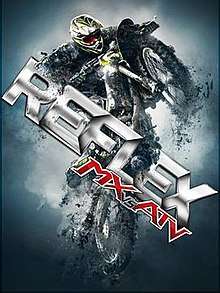MX vs. ATV Reflex
MX vs. ATV Reflex is an off-road racing video game developed by Rainbow Studios and published by THQ. It is the third game in the MX vs. ATV series, available on Microsoft Windows and all seventh-generation systems except the Wii. It is also the final game in the series to be available on handheld systems.
| MX vs. ATV Reflex | |
|---|---|
 | |
| Developer(s) | Rainbow Studios Tantalus Media (handhelds) |
| Publisher(s) | THQ |
| Series | MX vs. ATV |
| Platform(s) | Nintendo DS, PlayStation 3, PlayStation Portable, Xbox 360, Microsoft Windows |
| Release | Nintendo DS, PlayStation 3, PlayStation Portable & Xbox 360Microsoft Windows
|
| Genre(s) | Racing |
| Mode(s) | Single-player, Multiplayer (except PSP) |
Gameplay
The core focus of the game allows for the player to race motocross and supercross on motocross bikes or ATVs. The game also includes events such as omnicross, free ride, champion sport track, waypoint racing, and freestyle motocross.[1]
Although the game is part of the MX vs. ATV series, Reflex was built from the ground up featuring a new control scheme and physics engine. The new control scheme is labeled "reflex" which utilizes both analog sticks. The left analog controls the handlebars while the right analog stick controls the rider's body movement. The reflex system allows for unprecedented control and manipulation by allowing the player to 'ride' the motorcycle and other vehicles as they actually would. Tricks have been simplified from the previous games as the player only needs to hold the modifier button and use the right stick to make different combinations and flips.[1]
Also new to Reflex is real-time terrain deformation. Terrain deformation allows any of the different vehicles to literally carve into the earth creating ruts, berms, braking bumps and acceleration bumps as they actually do in real life. These ruts, berms and bumps are dynamic and constantly changing throughout the course of the race adding for an extra sense of realism.
Online mode on consoles and PC consists of public and private rooms. These rooms are dedicated to specific event types (i.e. supercross) and host up to twelve players at a single time. A player's "motocard" keeps record of the player's progress through online events which earns them experience points that go towards the player's level. Mini games such as snake and tag are played online as well. The console and PC versions also support offline, 2-player split screen multiplayer, while the Nintendo DS version also supports local wireless multiplayer between up to four players.
Development
Rainbow Studios art director Ian Wood stated in an interview with SPOnG that the development team decided against making a Wii version of Reflex, but did not provide a clear reason why. He hinted that the developers chose to skip it to focus efforts on designing Reflex's new physics and terrain deforming system,[2] key features that were better suited for the more powerful PlayStation 3, Xbox 360 and personal computers. Tantalus Media, which developed the handheld versions of the previous game, MX vs. ATV Untamed, was invited once again to develop handheld versions for Reflex.
Reception
The console and PC versions of MX vs. ATV Reflex generally received positive reviews. A large portion of praise has gone towards both the new control scheme as well as the terrain deformation. Many have acknowledged the game's successful separation of the rider from the machine with the rider reflex dual-analog control. The Metacritic average score is 78 on the Xbox 360,[3] and 77 on the PlayStation 3.[4]
Dakota Grabowski at GameZone gave the console versions an 8.0,[5] stating, "A wonderful foundation has been set and it’s now time for Rainbow Studios to expand on what they have set up with their next iterations. The future is bright and fans should be rejoicing."
GameSpot gave the console/PC versions a 7.0 saying "Unfortunately, things don't always work correctly in MX vs. ATV Reflex. Kinks in the physics system can lead to some unpredictable, chaotic rides." They also said, "Reflex is not a particularly good looking game on either system, with blurry, low-res textures that are distracting in the open world tracks."
IT Reviews acknowledged that "MX vs ATV isn't about pelting around with the throttle constantly revving to the max, rather the successful rider gets into the rhythm of the jumps. This is novel, and feels realistic." However, the reviewer complained about aspects of the single player game, including CPU riders who are "borderline psychopathic", truck driving that is "far too easily mastered" and a campaign mode which is "rather unimaginative and flat" on an overall level.[6]
By contrast, the handheld versions received scant reviews from critics and none of the praise for the other versions.[7][8] Chris Roper of IGN gave the PSP version a 4 out of 10 and the DS version a 5.7 out of 10, criticizing the controls and presentation.[9][10]
References
- Johnson, Mark (15 May 2009). "Interviews// MX vs ATV Reflex". SPOnG.com. Retrieved 19 June 2020.
- MX vs. ATV Reflex for Xbox 360 on Metacritic
- MX vs. ATV Reflex for PlayStation 3 on Metacritic/
- Archived December 13, 2009, at the Wayback Machine
- "IT Reviews". IT Reviews. Archived from the original on 2011-06-11. Retrieved 2012-08-18.
- MX vs. ATV Reflex for PSP
- MX vs. ATV Reflex for DS
- Roper, Chris (9 December 2009). "MX vs. ATV PSP Review". IGN. Retrieved 19 June 2020.
- Roper, Chris (11 December 2009). "MX vs. ATV Reflex DS Review". IGN. Retrieved 19 June 2020.